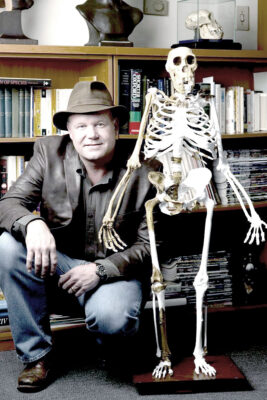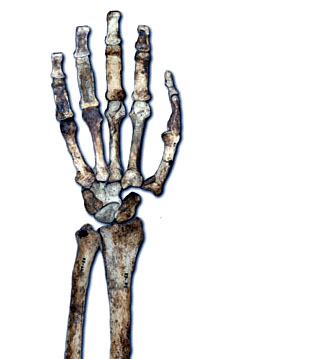 The Australopithecus sediba saga intensified last week with a new series of reports published in the journal of Science. The journal is the official weekly publication of the American Association for the Advancement of Science, AAAS.
The Australopithecus sediba saga intensified last week with a new series of reports published in the journal of Science. The journal is the official weekly publication of the American Association for the Advancement of Science, AAAS.
Last week’s edition (cover pictured left) featured eight articles and news reports specifically on A. sediba, inflaming a flurry of speculations on the human “missing link.”
This last week was the second Science edition to focus on human evolution findings in South Africa.
Earlier, in April 2010, Science featured the initial report of two A. sediba partial skeletons discovered by paleoanthropologist Lee R. Berger (pictured right) of the University of the Witwatersrand, South Africa, are entitled “Australopithecus sediba: A New Species of Homo-Like Australopith from South Africa.”
With Berger’s 2010 report, Science published the report of geologist Paul H. G. M. Dirks of the University of the Witwatersrand, entitled “Geological Setting and Age of Australopithecus sediba from Southern Africa.” Science journalist Michael Balter noted in “Candidate Human Ancestor From South Africa Sparks Praise and Debate,” this “may be the best candidate yet for the immediate ancestor of our genus, Homo.”
Sediba in the News
Last week’s edition of the journal Science featured eight articles and reports focusing on the A. sediba saga. Media coverage was quick and generous. The day before Science released the publication, The New York Times broke the story with “New Hominid Species Discovered in South Africa,” reporting Rick Potts’s, director of the Human Origins Program at the Smithsonian, comment –
“They are a fascinating mosaic of features. It reminds us of the combining and recombining of characteristics, the tinkering and experimentation that go on in evolution.”
National Public Radio (NPR) ran the story entitled “Examining Ancient Fossils for Clues to Human Origins.” The Wall Street Journal chimed in with “Fossil Trove Sheds Light on a Stage of Evolution.”
The Los Angeles Times story, “Hominid fossils may shake up the human family tree,” took a vague approach. National Geographic weighed in more optimistically with “Human Ancestor May Put Twist in Origin Story, New Studies Say.” As reported in Science, since the discovery raises more questions than answers, the story of human evolution by means of natural selection gets more challenging –
“Few other researchers are convinced that A. sediba was a direct ancestor of humans.”
Sediba Beginnings
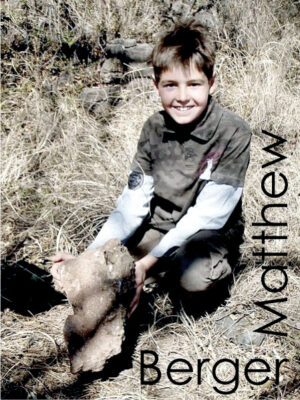 The saga began in August 2008 when South African paleoanthropologist Lee Berger’s nine-year-old son, Matthew (pictured left), stumbled upon a fossilized bone while exploring the hills north of Johannesburg on the Malapa Nature Reserve, and yelled, “Dad, I found a fossil!” As Lee later recalled –
The saga began in August 2008 when South African paleoanthropologist Lee Berger’s nine-year-old son, Matthew (pictured left), stumbled upon a fossilized bone while exploring the hills north of Johannesburg on the Malapa Nature Reserve, and yelled, “Dad, I found a fossil!” As Lee later recalled –
“Sticking out of the back of the rock was a mandible with a tooth, a canine, sticking out. And I almost died.”
The fossil Matthew found belonged to a 4-foot-2-inch male individual, the skull of which was discovered nearly a year later in March 2009 by Berger’s team. Sediba means “natural spring” to symbolize the spring from which humans evolved. According to Berger –
“They do represent a model that could lead to the genus Homo.”
In total, 220 bones belonging to five individuals have now been recovered in South Africa, an area touted as the “Cradle of Humankind,” conforming to the still controversial “out of Africa” theory of evolution.
Sediba Nicknamed Karabo
The A. sediba saga sparked an affectionate renaming campaign among South African schoolchildren. The naming competition, sponsored by Standard Bank and the Palaeontological Scientific (PAST) in association with Wits University, gathered more than 15,000 entries. The winning name was Karabo. In Setswana, Karabo means the “answer.”
Sediba Saga Critics
At issue, though, what are the human evolution answers from the A. sediba saga? For researcher Kristian Carlson (pictured right) at the University of Witwatersrand, 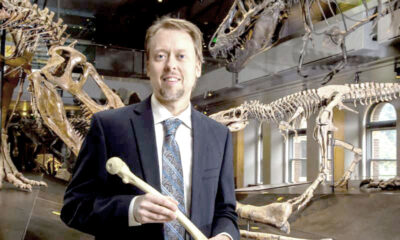
“Whether or not it’s on the same lineage as leading to Homo, I think there are interesting questions and implications.”
Questions and implications, however, are not to be confused with answers. For Philip Rightmire of Harvard University,
“Evolution is [now] more convoluted than we thought.”
Ironically, Matthew’s finding, rather than having an answer to the question of human evolution, only further complicates the problematic theory.
Paleontologists Timothy White of the University of California, Berkeley, and Ronald Clarke of the University of the Witwatersrand’s Institute for Human Evolution in Germany, in an accompanying news article published in Science, refute Berger’s claim that A. sediba represents a transitional species on the way up.
In the wake of the article this week in Science, anthropologist Bernard Wood (pictured left) of George Washington University noted –
“Just because it shares a bit of anatomical morphology with Homo does not mean it is Homo or ancestral to Homo.”
Writing in The Telegraph (UK), science writer Tom Chivers entitled his article “Australopithecus sediba: can we stop calling it a ‘missing link?… What it is not, however, is a ‘missing link.’”
A. sediba, however, was soon recognized as a new species and classified with the australopithecines. The most famous member of this group is Australopithecus afarensis, better known as Lucy, discovered in Ethiopia in November 1974 by Tom Gray and Donald Johanson.
In analyzing the skeletal features of Lucy, Charles E. Oxnard explained in his book The Order of Man (1984) –
“[It] is now being recognized widely that the australopithecines are not structurally … similar to humans.”
In the journal publication Natural History, Stephen Gould (pictured right), in 1986, took the same stand as Oxford against the human ancestry of A. afarensis: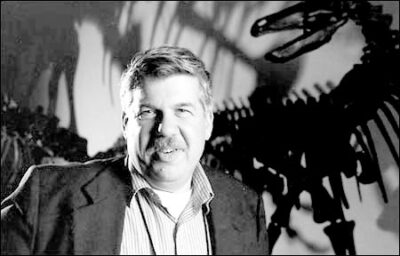
“In short, he [Oxnard] sees Australopithecines as uniquely different from apes and humans, not as imperfect people on the way up.”
Later in 1987, in Natural History, Stephen Gould acknowledged that problems with the fossil evidence for human evolution overwhelm any cohesive theory since –
“We do not know which branch on the copious bush of apes budded off the twig that led to our lineage … no fossil evidence exists at all.”
Ann Gibbons published in the journal Science in 1996 about how convoluted the evidence for human evolution has become:
“The story of human evolution has lately become as complicated as a Tolstoy novel.”
“They’re going to have to make a stronger case,” said paleoanthropologist Donald Johanson of Arizona State University, who discovered Lucy. Johanson, a friend of Berger’s who has seen the fossils, said the only solution would be to look for more evidence.
“I know this is a terrible thing to say,” he said. “But we’d all like to [understand] the shape of the [human family] tree and the positions on the tree — and we really do need more fossils.”
In the 1976 Presidential Address at the Geological Association, D. V. Ager, dismayed at the fossil record, went on the record to say –
“It must be significant that nearly all the evolutionary stories I learned as a student … have now been ‘debunked.’”
The fossil record problem continues to be a question mark − not an answer, not a Karabo. In The Panda’s Thumb, evolutionary paleontologist Stephen Gould, feeling the agony, noted that in reality,
“[The] fossil record had caused Darwin more grief than joy.”
Genesis
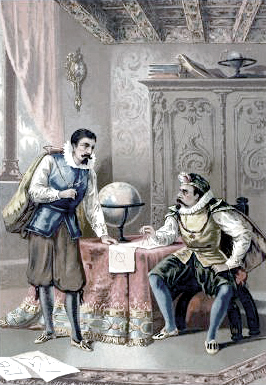 The Australopithecus sediba saga demonstrates how the evolution industry sells a philosophy as an irrefutable scientific fact, even when knowing otherwise. But the tricks work. Evolution is now even center-stage in the 2012 Presidential campaign. If you don’t believe evolution, you are a “science denier,” they say.
The Australopithecus sediba saga demonstrates how the evolution industry sells a philosophy as an irrefutable scientific fact, even when knowing otherwise. But the tricks work. Evolution is now even center-stage in the 2012 Presidential campaign. If you don’t believe evolution, you are a “science denier,” they say.
While the identity of Darwin’s elusive transitional links for Homo sapiens remains elusive, the Genesis account written by Moses is compatible with the South African fossil record.
Johannes Kepler (pictured right), the German mathematician, astronomer, and pioneer of the scientific revolution, is best known for his publications Astronomia nova, Harmonices Mundi, and Epitome of Copernican Astronomy – observations that provided the foundations for Isaac Newton‘s theory of universal gravitation. In the words of Kepler during the Scientific Revolution –
“I thank Thee, my Creator and Lord, that Thou hast given me this joy in Thy creation, this delight in the works of my hands;
Evidence for common ancestry and transitional links underscores why the theory of evolution remains speculative but not scientifically valid.
Australopithecus Sediba Saga is a Fossil Record article.
Darwin Then and Now is an educational resource on the intersection of evolution and science, highlighting the ongoing challenges to the theory of evolution.
Move On
Explore how to understand twenty-first-century concepts of evolution further using the following links –
-
- The Understanding Evolution category showcases how varying historical study approaches to evolution have led to varying conclusions. Subcategories include –
- Studying Evolution explains how key evolution terms and concepts have changed since the 1958 publication of The Origin of Species.
- What is Science explains Charles Darwin’s approach to science and how modern science approaches can be applied for different investigative purposes.
- Evolution and Science feature study articles on how scientific evidence influences the current understanding of evolution.
- Theory and Consensus feature articles on the historical timelines of the theory and Natural Selection.
- The Biography of Charles Darwin category showcases relevant aspects of his life.
- The Glossary defines terms used in studying the theory of biological evolution.
- The Understanding Evolution category showcases how varying historical study approaches to evolution have led to varying conclusions. Subcategories include –
Sediba Saga 2020 Update
WIKIPEDIA, 2020
“Morphologically, A. sediba is distinct from but still closely related to both Homo habilis and Australopithecus africanus. It is, therefore, of interest as a candidate for a transitional species in the emergence of the Homo (human) genus.”
“As opposed to the authors of the initial description, who interpreted both fossils as a possible transitional species between Australopithecus and Homo, other palaeoanthropologists are reluctant to do so. In an accompanying news article published with the initial descriptions in 2010, detractors of the idea that A. sediba might be ancestral to the genus Homo suggest that the fossils could be a late southern African branch of Australopithecus, coexisting with already existing members of the genus Homo.”
Evolution 101, 2020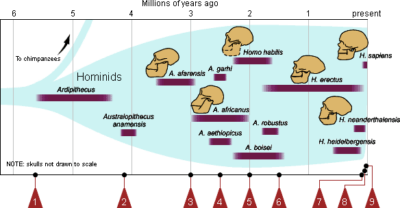
There is no written text to describe Australopithecus sediba, and the human tree of life diagram (pictured right) does include Australopithecus sediba.
Smithsonian, 2020
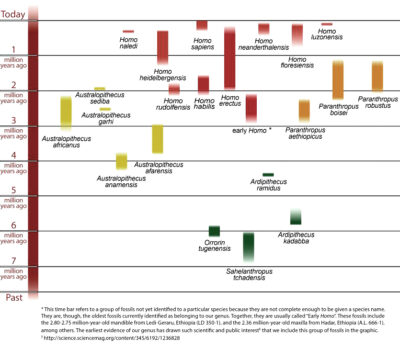 Following the Human Fossils to the Species page, Australopithecus sediba appears along with the twenty other human-like species. A human tree of life diagram, updated in 2019 (pictured left), includes Australopithecus sediba.
Following the Human Fossils to the Species page, Australopithecus sediba appears along with the twenty other human-like species. A human tree of life diagram, updated in 2019 (pictured left), includes Australopithecus sediba.

